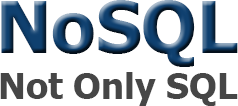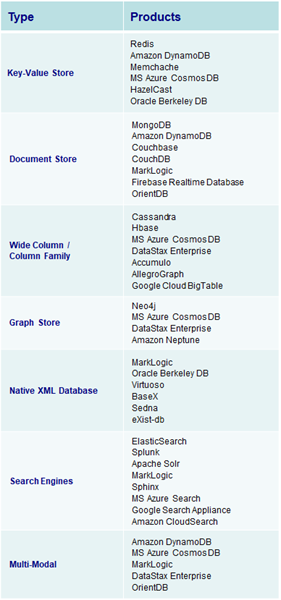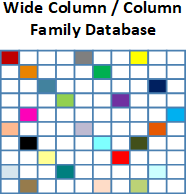Definition of NoSQL
 Recently, NoSQL databases have been developed that provide a high-performance and salable alternative to more traditional relational database management systems (RDBMS), especially when dealing with large amounts of unstructured or semi-structured data. NoSQL, which stands for “Not Only SQL” (https://en.wikipedia.org/wiki/NoSQL) is unlike RDBMS as it is designed for processing large collections of distributed data that don’t fit well into strict rows and columns. And NoSQL databases are ideal solutions for implementations of Big Data initiatives. Moreover, the substantial increase in amount, speed, and variation of Big Data in recent years has greatly increased the need for deployments of NoSQL databases. While traditional RDBMS are very useful for the processing of highly-structured data, NoSQL databases typically accommodate either semi-structured data, fully-unstructured data, documents, graphs, or dynamic schema. And NoSQL databases are now widely recognized for their ease of development, functionality, and performance at scale.
Recently, NoSQL databases have been developed that provide a high-performance and salable alternative to more traditional relational database management systems (RDBMS), especially when dealing with large amounts of unstructured or semi-structured data. NoSQL, which stands for “Not Only SQL” (https://en.wikipedia.org/wiki/NoSQL) is unlike RDBMS as it is designed for processing large collections of distributed data that don’t fit well into strict rows and columns. And NoSQL databases are ideal solutions for implementations of Big Data initiatives. Moreover, the substantial increase in amount, speed, and variation of Big Data in recent years has greatly increased the need for deployments of NoSQL databases. While traditional RDBMS are very useful for the processing of highly-structured data, NoSQL databases typically accommodate either semi-structured data, fully-unstructured data, documents, graphs, or dynamic schema. And NoSQL databases are now widely recognized for their ease of development, functionality, and performance at scale.
The term NoSQL can be applied to some databases that were available before traditional RDBMS, but more often the term refers to databases developed in the mid to late 2000s for the purpose of large-scale database processing within web and mobile based applications. Within these emerging applications, requirements for performance and scalability outweighed the conventional requirement for the rigid data consistency that existing RDBMS provided to transactional applications. Subsequently, NoSQL databases for web applications have tended to focus on very specific characteristics of data management. The ability to process very large volumes of data and quickly distribute that data across computing processors and clusters has been very desirable in large-scale web application design. There has also been a greater need for flexible data schema, or no schema at all, in order to better implement rapid changes to applications.
An advantage of NoSQL databases over traditional RBMS is that they store and manage data in ways that allow for high operational speed and great flexibility on the part of system developers. In addition, data can be stored in a schema-less or free-form fashion. Any data can be stored in any record. And unlike traditional RDBMS, many NoSQL databases can be scaled horizontally across hundreds or thousands of commodity servers. And NoSQL databases typically utilize lower amounts system memory than RDBMS. This allows for NoSQL databases to achieve much higher performance than traditional RDBMS.
NoSQL Databases Typically Contain the Following Types of Data:
• Semi-structured Data: CSV, Word, Excel, PowerPoint, Documents, PDFs, Logs, XML, JSON
• Unstructured Data: Emails, Text, Messages, Blog Entries, Twitter
• Binary Data: Graphics, Images, Audio, Video
NoSQL Database Types
• Key-Value Stores: A simple data storage system that pairs a unique key with an associated value. Typical uses include: dictionaries, image stores, document/file stores, query cache, lookup tables.
• Document Stores: Data stores that pair each key with a complex data structure known as a document. Documents are typically semi-structured either in XML or JSON formats. Typical uses include: MS Word documents, MS Excel documents, spreadsheets, presentations, PDF files, sales orders, invoices, product descriptions, web pages, forms.
• Graph Stores: Data stores that organize data as nodes, which are like records in a relational database, and edges, which represent connections between nodes. Typical uses include: social networks, fraud detection, pattern matching, relationship-heavy data.
• Wide Column / Column Family Stores: Data stores that have the ability to hold very large numbers of dynamic columns. But unlike a relational database, the names and format of the columns can vary from row to row in the same table. Typical uses include: web crawling, large sparsely populated tables, highly-adaptive systems, high-variance systems.
• Native XML Databases: Data stores that allow data to be stored in the extensible markup language (XML) format, a markup language that defines a set of rules for encoding documents in a format that is both human-readable and machine-readable. XML databases are a sub-category of document stores.
• Search Engines: Information retrieval systems designed to help find information stored on a computer system.
• Multi-Modal Databases: Data stores that contain aspects of multiple types of NoSQL database all within one product.
NoSQL Database Products (2018)

 Wide column / column family databases are NoSQL databases that store data in records with an ability to hold very large numbers of dynamic columns. Columns can contain null values and data with different data types. In addition, data is stored in cells grouped in columns of data rather than as rows of data. Columns are logically grouped into column families. Column families can contain a virtually unlimited number of columns that can be created at run-time or while defining the schema. And column families are groups of similar data that is usually accessed together. Additionally, column families can be grouped together as super column families.
Wide column / column family databases are NoSQL databases that store data in records with an ability to hold very large numbers of dynamic columns. Columns can contain null values and data with different data types. In addition, data is stored in cells grouped in columns of data rather than as rows of data. Columns are logically grouped into column families. Column families can contain a virtually unlimited number of columns that can be created at run-time or while defining the schema. And column families are groups of similar data that is usually accessed together. Additionally, column families can be grouped together as super column families.


 Recently,
Recently, 